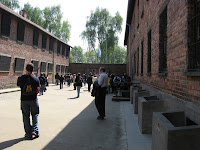Tuesday, May 11--- Auschwitz-Birkenau is a major point on our group's itinerary. Prof. Edyta Gawron and I had discussed when the students should go and we'd agreed: after students had learned about the long history of Jewish settlement in Poland and had walked the Kazimierz district in Krakow. We enter the old camp, Kl I (Konzentrationslager I) or Auschwitz I, under the cynical motto of all the camps.
It's only about 9:30 am, but many groups are ahead of us---each with its own language guide. I'm impressed by each visit (this is my 4th) at the cadre of docents and how well trained they are. We step onto the poplar-lined paths that chart the visitors' route through the former World War I Polish army barracks the Nazis commandeered in spring of 1940, just months after invading Poland. The solidity of the concrete columns of double electrical fencing show how hopeless was the idea of escape.
The block house corridor walls are lined with the photos of inmates, male and female, young and old; these were the early prisoners whose passing utility as forced labor warranted camera and tattoo. Their eyes look out at a camera as they were months before death, perhaps a year or more if they were stronger. Outside is the execution courtyard wall, below are solitary confinement, standing cells. More blocks and corridors lead to rooms where we peer through glass at mounds of now gray-brown utensils, glasses, shoes, a small fraction of the tons of objects hoarded here for use in the Reich. Cream and black prayer shawls in soft, fine wool hang immobile on rods---they would have covered swaying shoulders.
It's only about 9:30 am, but many groups are ahead of us---each with its own language guide. I'm impressed by each visit (this is my 4th) at the cadre of docents and how well trained they are. We step onto the poplar-lined paths that chart the visitors' route through the former World War I Polish army barracks the Nazis commandeered in spring of 1940, just months after invading Poland. The solidity of the concrete columns of double electrical fencing show how hopeless was the idea of escape.
The block house corridor walls are lined with the photos of inmates, male and female, young and old; these were the early prisoners whose passing utility as forced labor warranted camera and tattoo. Their eyes look out at a camera as they were months before death, perhaps a year or more if they were stronger. Outside is the execution courtyard wall, below are solitary confinement, standing cells. More blocks and corridors lead to rooms where we peer through glass at mounds of now gray-brown utensils, glasses, shoes, a small fraction of the tons of objects hoarded here for use in the Reich. Cream and black prayer shawls in soft, fine wool hang immobile on rods---they would have covered swaying shoulders.
We walk past past other landmarks---guard boxes, the kitchen, a gallows, the commendant's residence, a small, modest villa with flower beds, and finally reach the spot to the right of the old crematorium (later replaced by 4 crematoria when Birkenau was developed); here, after trial, Rudolf Franz Hoess was hanged in 1947.






No comments:
Post a Comment